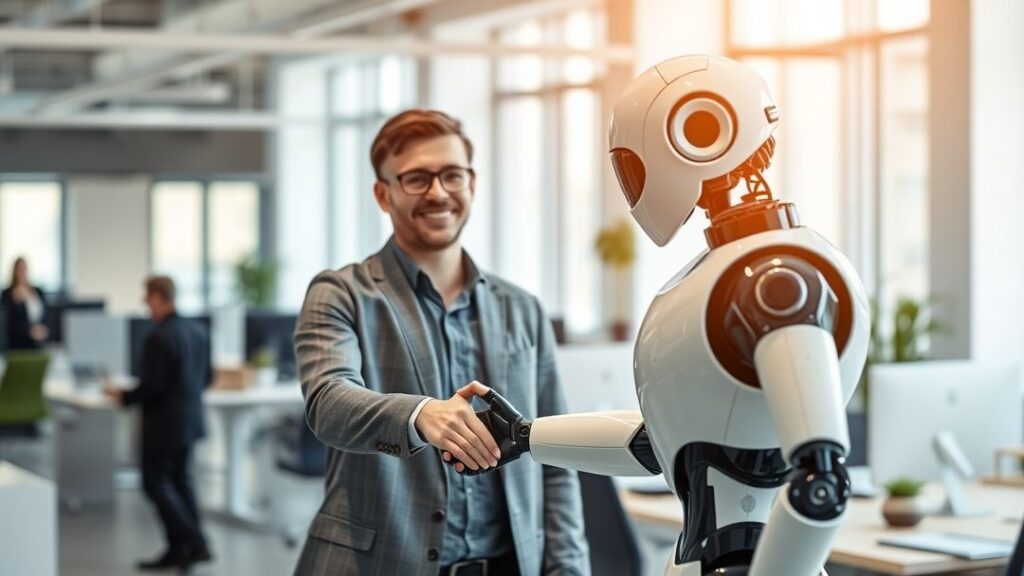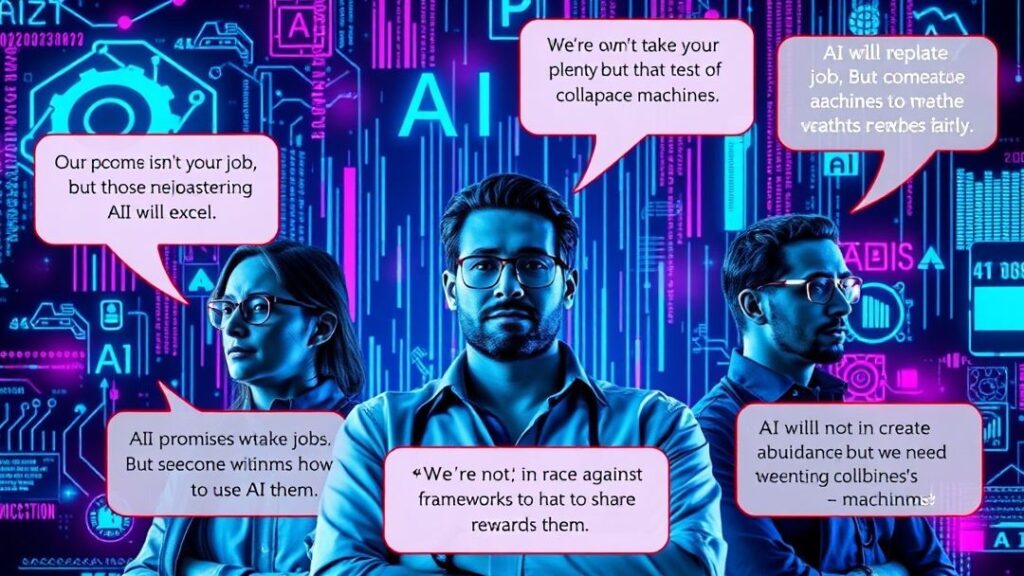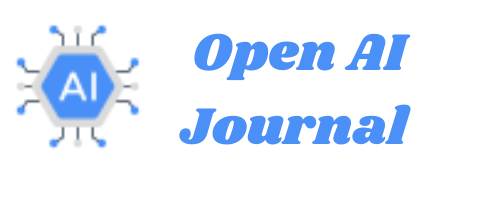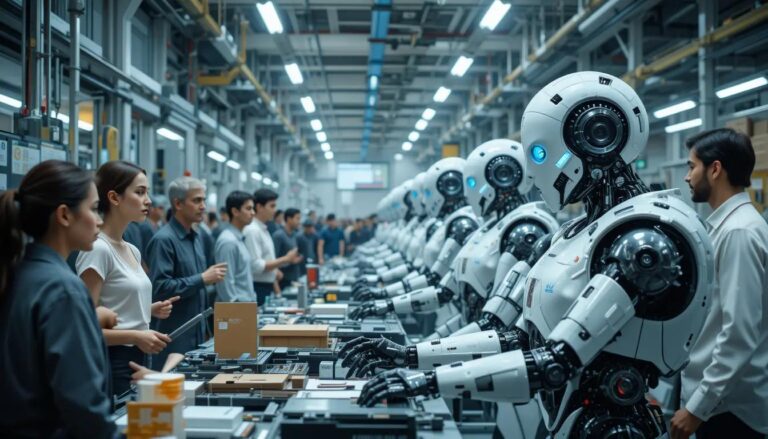Will AI Take Your Job? The Truth About Automation

Table of Contents
Artificial Intelligence (AI) is no longer a distant concept reserved for sci-fi movies—it’s here, and it’s transforming how we live and work. As tools like ChatGPT, Midjourney, and AI-powered analytics take center stage, millions are asking the same burning question: Will AI take your job?
The fear of AI replacing humans isn’t new. From the industrial revolution to the rise of the internet, technological disruption has always reshaped the workforce. But unlike past revolutions, AI threatens to automate not just manual labor but also knowledge work—jobs once thought untouchable.
In this deep dive, we’ll uncover:
- The jobs most at risk from AI automation
- How AI is creating new roles
- What skills you need to stay relevant
- What experts and economists predict
- Real examples of industries already transformed
Let’s separate fear from fact and explore the real impact AI will have on your job.
1. The Rise of AI in the Workplace

Artificial Intelligence (AI) has transitioned from a futuristic concept to an integral component of modern workplaces. Its adoption is reshaping industries, altering job roles, and redefining productivity metrics.
Accelerated Adoption Across Industries
Recent studies indicate a significant uptick in AI integration within businesses. According to McKinsey’s 2024 Global Survey, 65% of organizations report regular use of generative AI, nearly doubling from the previous year. This surge is not confined to tech-centric companies; sectors like healthcare, finance, and manufacturing are increasingly leveraging AI for various functions.
Executive Engagement and Strategic Implementation
C-level executives are leading the charge in AI adoption. McKinsey’s findings reveal that 53% of surveyed executives regularly use generative AI at work, compared to 44% of mid-level managers. This top-down approach underscores the strategic importance placed on AI, signaling a shift from experimental use to core business strategy.
Employee Readiness and Utilization
Interestingly, there’s a disparity between executive perceptions and employee usage of AI. While executives estimate that only 4% of employees use generative AI for at least 30% of their daily work, actual usage is closer to 13%. This gap suggests that employees are more prepared and willing to integrate AI into their workflows than leadership anticipates.
Challenges in Scaling AI
Despite widespread adoption, many organizations struggle to scale AI effectively. McKinsey’s research indicates that while nearly all companies invest in AI, only 1% believe they have reached maturity in its implementation. The primary barriers include lack of clear strategy, insufficient talent, and challenges in integrating AI into existing systems.
Economic Implications
The economic impact of AI is profound. Goldman Sachs estimates that generative AI could raise global GDP by 7%, highlighting its potential to drive significant economic growth. However, this growth is contingent upon effective integration and addressing the challenges associated with AI deployment.S
2. Jobs at Risk: Who Should Be Concerned?
The integration of AI into the workplace brings both opportunities and challenges. While it enhances efficiency and creates new roles, it also poses risks to certain job categories.
To better understand the situation, let’s break down the current and projected job dynamics using available labor statistics and industry forecasts:
| Category | Jobs at High Risk | Jobs Being Created by AI |
|---|---|---|
| Customer Service | Call center reps, support agents | AI trainers, chatbot QA specialists |
| Transportation & Logistics | Truck drivers, warehouse pickers | Robotics technicians, AI fleet managers |
| Administrative & Clerical | Data entry, schedulers | Workflow automation designers |
| Retail | Cashiers, inventory clerks | E-commerce analysts, UX researchers |
| Media & Marketing | Basic content writers | Prompt engineers, AI content editors |
| Finance & Legal | Junior analysts, paralegals | AI auditing professionals, compliance experts |
High-Risk Occupations
Goldman Sachs reports that up to 300 million full-time jobs globally could be automated, particularly affecting roles involving repetitive tasks. Occupations such as data entry clerks, administrative assistants, and telemarketers are among the most vulnerable.
Sector-Specific Vulnerabilities
The impact of AI varies across sectors. In manufacturing, automation threatens assembly line jobs, while in the service industry, AI-powered chatbots and virtual assistants could replace customer service representatives. The transportation sector faces disruptions with the advent of autonomous vehicles, potentially affecting drivers and delivery personnel.
Geographic Disparities
The risk of job displacement due to AI is not uniform globally. Developed economies, with higher labor costs and greater technological infrastructure, are more susceptible to automation. Conversely, developing countries may experience slower adoption, providing a buffer period to adapt and reskill their workforce.
Socioeconomic Implications
Job displacement can exacerbate existing socioeconomic inequalities. Workers with lower educational attainment and limited access to reskilling opportunities are particularly at risk. This underscores the need for inclusive policies that support vulnerable populations during the transition.
3. Not All Doom and Gloom: AI is Creating Jobs Too

While AI poses risks to certain job categories, it simultaneously creates new opportunities, reshaping the employment landscape.
Emergence of New Roles
The World Economic Forum projects that AI and automation will create 97 million new jobs by 2025. These roles span various domains, including data analysis, AI system development, and digital marketing. The demand for professionals who can develop, manage, and maintain AI systems is on the rise.
Transformation of Existing Jobs
AI doesn’t just create new jobs; it also transforms existing ones. For instance, in healthcare, AI assists in diagnostics, allowing medical professionals to focus more on patient care. In education, AI-powered tools personalize learning experiences, enabling teachers to address individual student needs more effectively.
Economic Growth and Productivity
The integration of AI can lead to increased productivity and economic growth. By automating routine tasks, employees can focus on higher-value activities, fostering innovation and efficiency. This shift can result in the creation of more fulfilling and better-paying jobs.
Importance of Reskilling
To capitalize on the opportunities presented by AI, reskilling and upskilling are crucial. Governments and organizations must invest in training programs that equip workers with the necessary skills to thrive in an AI-driven economy. This proactive approach can mitigate job displacement and ensure a smooth transition.
4. How to Future-Proof Your Career in the Age of AI
Navigating the evolving job market requires adaptability and a commitment to continuous learning. Here are strategies to future-proof your career amid AI advancements.
Embrace Lifelong Learning
Continuous education is vital. Engaging in courses, workshops, and certifications can help you stay abreast of technological trends and acquire new competencies. Platforms offering online learning resources make it easier to access education tailored to emerging industry needs.
Develop Soft Skills
While technical skills are important, soft skills like critical thinking, creativity, and emotional intelligence are equally valuable. These human-centric abilities are less susceptible to automation and are essential in roles that require complex problem-solving and interpersonal interactions.
Stay Technologically Literate
Understanding the basics of AI and related technologies can enhance your adaptability. Familiarity with tools and platforms used in your industry can increase your efficiency and make you a more competitive candidate.
Network and Collaborate
Building a strong professional network can provide insights into industry trends and open up new opportunities. Collaborating with peers allows for knowledge sharing and can lead to innovative solutions to common challenges.
Seek Guidance and Mentorship
Mentors can offer valuable advice and support as you navigate career transitions. Their experience can provide perspective on how to adapt to changes and identify growth areas within your field.
5. Real Industry Case Studies
The integration of Artificial Intelligence (AI) into various industries has led to significant transformations, offering both opportunities and challenges.
Amazon: Balancing Efficiency and Employee Well-being
At Amazon, AI has been instrumental in enhancing operational efficiency. However, this integration has also introduced new challenges for employees. Software engineers report increased pressure to deliver results faster, with AI tools accelerating project timelines. While these tools are designed to assist, they often lead to higher expectations and reduced team sizes, causing concerns about job satisfaction and career development.
Klarna: Reassessing Automation Strategies
Swedish fintech company Klarna initially embraced AI by laying off approximately 700 employees to automate operations. However, the company later recognized the limitations of full automation and began rehiring human staff. This shift underscores the importance of a balanced approach that combines human expertise with AI capabilities.
Healthcare: Introducing AI-Powered Nurse Robots
In the healthcare sector, AI-powered nurse robots like Nurabot have been introduced to address staff shortages and reduce burnout. These robots patrol hospital corridors, monitor patient vitals, and deliver medications, aiming to reduce nurse workload by 30%. While they offer support, concerns about job displacement and the ethical implications of AI in patient care persist.
6. Expert Opinions: What the Thought Leaders Say

The discourse around AI’s impact on employment is enriched by insights from industry experts and thought leaders.
Sam Altman, CEO of OpenAI, emphasizes the need for realistic expectations regarding AI’s capabilities. He acknowledges the technology’s potential but warns against overhyping its current abilities, suggesting that while AI can augment human work, it is not yet poised to replace it entirely.
Industrial designer Ross Lovegrove views AI as a valuable complement to human creativity. He integrates AI into his design processes, leveraging its capabilities to enhance innovation while maintaining the human touch in his work.
Cornelia Walther, a visiting scholar, advocates for hybrid intelligence—a collaboration between human and artificial intelligence. She argues that combining AI’s computational strengths with human insight leads to more sustainable and trustworthy outcomes.
7. Ethical Concerns and Economic Impact
The rapid adoption of AI raises significant ethical questions and economic considerations.
Job Displacement and Economic Inequality
AI’s potential to automate tasks poses a risk of job displacement, particularly in roles involving repetitive tasks. This shift could exacerbate economic inequalities if not managed with inclusive policies and reskilling programs.
Bias and Fairness in AI Systems
AI systems can inadvertently perpetuate biases present in their training data, leading to unfair outcomes in areas like hiring and lending. Ensuring transparency and fairness in AI algorithms is crucial to prevent discrimination and maintain public trust.
Privacy and Data Security
The use of AI often involves processing vast amounts of personal data, raising concerns about privacy and data security. Establishing robust data protection measures is essential to safeguard individual rights in the digital age.
8. The AI + Human Future: Collaboration, Not Competition
Rather than viewing AI as a threat, embracing it as a collaborative partner can unlock new possibilities.
Enhancing Human Capabilities
AI can augment human abilities by handling routine tasks, allowing individuals to focus on more complex and creative aspects of their work. This synergy can lead to increased productivity and job satisfaction.
Fostering Innovation Through Collaboration
Collaborative intelligence—where humans and AI work together—can drive innovation across industries. By combining human intuition with AI’s analytical power, organizations can develop novel solutions to complex problems.
Preparing for the Future Workforce
To thrive in an AI-integrated workplace, individuals should focus on developing skills that complement AI, such as critical thinking, emotional intelligence, and adaptability. Continuous learning and reskilling will be key to staying relevant in the evolving job market.
Final Thoughts: Will AI Take Your Job?
If you’ve been wondering whether AI will take your job, the answer is more layered than a simple yes or no. The fear is understandable. Headlines scream of mass automation, layoffs, and robotic replacements. And in some cases, that’s already playing out.
Historically, every major technological leap — from the steam engine to the internet — has triggered fears of job loss. Yet each also gave rise to new industries, professions, and skill sets that no one could have predicted at the time. AI is following the same pattern, albeit at an accelerated pace. For example, while AI-powered chatbots may reduce the need for entry-level support agents, they also open up new roles in AI training, supervision, prompt engineering, and ethics compliance.
While some roles will indeed disappear, others are evolving or being born. The question shifts from “Will AI take my job?” to “Is my job evolving, and am I evolving with it?” That shift in mindset is critical. Instead of resisting AI or ignoring its growth, individuals and companies should ask how to work with it—how to leverage it to improve productivity, creativity, and impact.
Moreover, AI lacks emotional intelligence, ethical judgment, and contextual reasoning—skills inherently human. These traits remain in high demand and are difficult to replicate, which means that jobs requiring empathy, strategy, leadership, and creative problem-solving will not only survive but thrive.
The key takeaway? AI is not the enemy. The real risk lies in being unprepared. If we embrace lifelong learning, develop uniquely human skills, and stay adaptable, the future looks far more like a partnership than a battle. So yes, AI will reshape the job market—but it doesn’t have to replace you. It can empower you—if you’re ready.
TL;DR (Too Long; Didn’t Read)
AI is changing the workplace, but it’s not here to take every job. While roles with repetitive, predictable tasks are at risk, AI is also creating a range of new job opportunities in emerging fields. Think AI trainers, ethics officers, and automation specialists. Jobs that rely on creativity, emotional intelligence, leadership, and strategic thinking remain safe—and arguably more important than ever.
The future of work won’t be AI vs. humans. It’ll be humans working with AI. If you adapt, reskill, and keep learning, you’ll not only remain relevant—you’ll thrive.
| Quick Recap | Details |
|---|---|
| Jobs at Risk | Call center reps, clerks, data entry, drivers |
| AI-Created Jobs | Prompt engineers, AI trainers, ethics compliance, automation designers |
| Most Secure Jobs | Creative professionals, strategists, healthcare, leadership roles |
| Key Future-Proof Skills | Emotional intelligence, adaptability, critical thinking, ethical reasoning |
| Main Takeaway | Embrace AI as a tool—not a threat—and stay ahead through lifelong learning |
Frequently Asked Questions (FAQ)
How do I stop AI from taking my job?
That’s the million-dollar question, right? The good news is, it’s not about “stopping” AI—it’s about staying a few steps ahead of it. Think of AI not as a competitor, but as a tool. The key is to focus on the skills AI can’t replicate: creativity, emotional intelligence, strategic thinking, leadership, and ethical decision-making.
A report by the World Economic Forum (2023) found that while 85 million jobs may be displaced by AI by 2025, 97 million new roles will be created that are better suited to the new division of labor between humans and machines. That’s a net gain—if we’re prepared.
For me personally, when AI tools like ChatGPT and Jasper started writing articles, I didn’t panic. Instead, I started learning prompt engineering and AI-assisted editing—skills that complement my journalism background. As a result, I didn’t lose relevance; I gained leverage.
Start with small shifts: take online courses, ask your manager about future-proofing your role, and stay informed on how AI is evolving in your industry. Lifelong learning isn’t just a cliché—it’s the best armor you’ve got.
What jobs will be lost by 2030?
By 2030, expect to see serious disruption in roles that are routine, predictable, and process-driven. According to McKinsey Global Institute, up to 375 million workers globally (that’s about 14% of the global workforce) may need to switch occupational categories by 2030 due to automation.
Here’s a quick breakdown of at-risk roles:
| Job Sector | Roles Likely Affected |
|---|---|
| Manufacturing | Assembly line workers, quality testers |
| Administrative | Data entry clerks, receptionists |
| Transportation | Truck drivers, delivery personnel |
| Retail | Cashiers, shelf stockers |
| Customer Service | Call center agents, helpdesk support |
But again, these aren’t gone forever—they’re changing. Retail jobs might evolve into customer experience design roles. Admins could become workflow automation specialists. Change is coming, yes, but so is reinvention.
What jobs will be at risk with AI?
The jobs most at risk are those that involve repetitive, rules-based tasks—the kind that can be described in a flowchart. Think bookkeeping, data processing, simple legal review, and entry-level tech support. A PwC report suggests that up to 30% of jobs are at high risk of automation by the mid-2030s, especially in sectors like finance, transportation, and retail.
That said, “at risk” doesn’t mean “obsolete.” AI may take over parts of these jobs, but hybrid roles are already emerging. For example, a paralegal might now use AI to draft templates, but still needs human judgment to finalize case prep.
In my own experience working with tech startups, many routine QA (quality assurance) roles have shifted to AI-assisted testers who collaborate with machine tools. Instead of being eliminated, the role simply got upgraded—and the people who adapted, stayed.
How long before AI takes my job?
It depends on your industry and how adaptable you are. In some sectors like logistics or data entry, automation is already here. In others—like healthcare, education, or journalism—AI might assist but won’t replace humans anytime soon.
According to a 2023 OECD report, 27% of jobs are highly automatable, but most will evolve slowly over the next 5–15 years, not overnight. For instance, it’s not that AI will “suddenly” replace a marketing analyst—it will gradually take over tasks like keyword research or A/B testing, allowing humans to focus on strategy and storytelling.
So the real timeline depends more on how fast your company and role adapt AI, not on a universal clock. The earlier you start learning how to collaborate with AI tools, the more future-proof your job becomes.
Will I lose my job due to AI?
Honestly? It’s possible—but not inevitable. What’s more likely is that your job will change dramatically, and whether you stay in it will depend on how ready you are for that change.
AI won’t replace jobs; people using AI will. That might sound cliché, but it’s true. In one case study, IBM’s Watson helped radiologists by analyzing medical images faster—but radiologists who embraced AI saw their diagnostic accuracy increase by 20%, making them more valuable than ever.
I’ve seen colleagues in journalism who resisted AI get left behind, while others who learned how to use tools like Grammarly, SurferSEO, and ChatGPT ended up with faster workflows and better content performance. The difference wasn’t skill—it was attitude.
You don’t need to fear AI—you need to partner with it.
How do I protect my work from AI?
If your work is online—whether that’s art, writing, code, or training data—there’s a chance it could be used to train AI systems. Protecting it is a mix of legal awareness, technical tools, and active visibility.
- Use metadata and copyright protections. Adding digital watermarks or “noAI” tags to your work can deter scraping (though not perfectly).
- Know your rights. The U.S. Copyright Office has released new guidance in 2024 that distinguishes between human-authored and AI-generated content, so make sure your work is registered correctly.
- Build your brand. AI can mimic style, but it can’t replace personality. The more you put your face, voice, and story into your work, the harder it is for AI to duplicate it. That’s why personal branding is the new job security.






